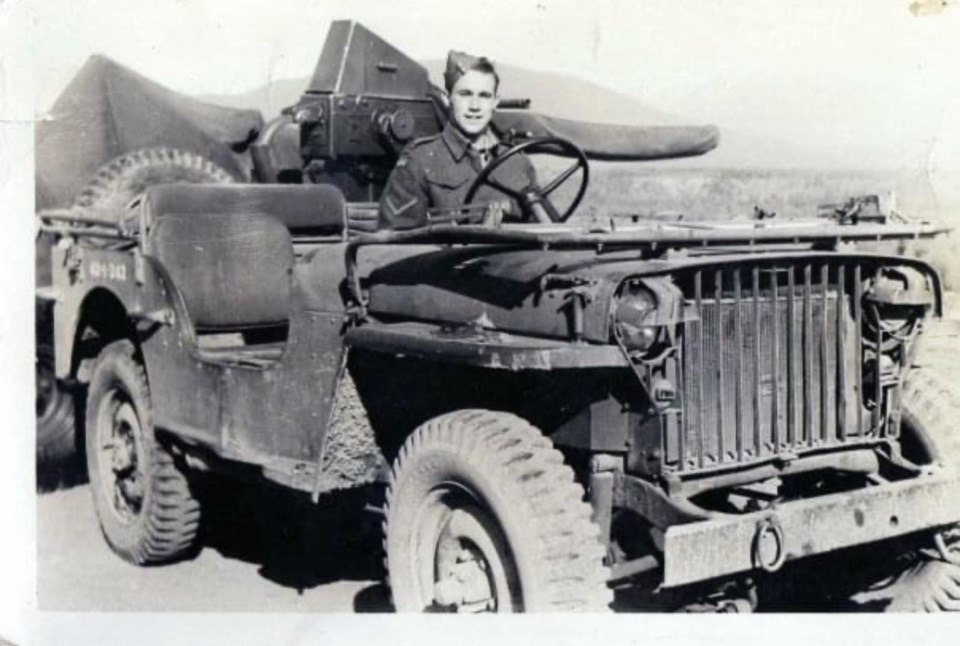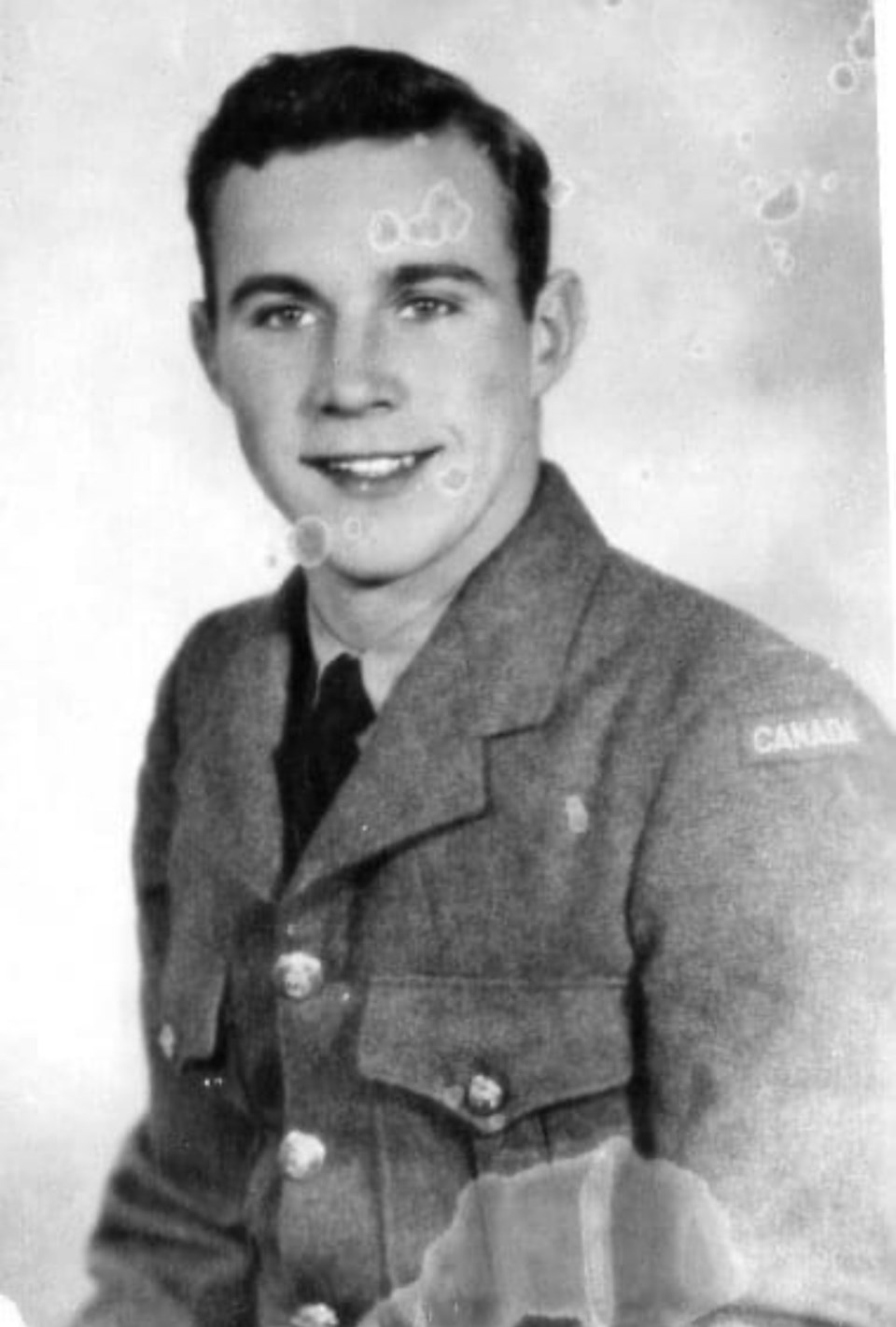Norris “ Bud” Chadwick of Point Edward had no idea that an item he found on a nondescript road in Italy during WWII would save his life.
An infantryman in the Battle of Italy, Bud had experienced first hand the devastation and horrors that war inflicted as the Allies sought to take Italy from the Germans. Every day brought constant fear and, with danger ever present, Bud figured he needed whatever edge he could find to survive.
By happenstance, he found that edge, his good luck charm, in November 1943.
Bud's talisman, though, was atypical—not a rabbit's foot, a special coin, a pair of dice, or a set of small horseshoes that he hung about his neck.
As Bud explained, “As a soldier with the Perth Regiment in Italy, we were on the move again, marching on both sides of the road. I was on the left hand side when I spotted a small pair of shoes in a low spot.”
After checking for booby traps, Bud reached down and shoved both shoes in his tunic. Later, when his company had stopped for a rest, he took the shoes out and examined them more closely. They were nothing extraordinary—just a simple pair of shoes for a young boy—but after deliberating, Bud had other plans for them.
“I decided they would be my 'Good Luck Charm' so back they went into my pack.” A pair of young boys' shoes for protection? Whether this decision was just a hunch or one born out of desperation, Bud never did say. However improbable it was at the time, Bud's decision proved to be very wise. After he had survived the war and returned to Point Edward, Bud knew that his good luck charm had protected him.
Born on October 10, 1920, in Point Edward, Bud became an ironworker in his teens and it was his profession for life. He helped build the first span of the Bluewater Bridge that opened in 1938 and four years later, at age 22, he married the love of his life, Marie Hardwick. Shortly after, he enlisted with the Perth Regiment in Stratford, Ontario.
After training in England, the Perth Regiment arrived in Italy as part of the 11th Infantry Brigade, 5th Canadian Armoured Division. Liberating Italy from the Germans was a difficult task. Doing so took 20 months and proved to be a painstaking northward crawl over a range of landscapes, through challenging weather, and against a series of well-protected positions defended by some of the German army’s best troops. Over 5,000 Canadian soldiers died in the effort.
Bud's good luck shoes were with him every step of the way, except on one occasion. He had loaned them to “one of the boys who was going on leave and he felt a little uneasy until they were safely back where they belonged.”
The Perth Regiment helped the Allies successfully breach the Gustav Line and the Hitler Line, two formidable lines of fortifications in central Italy that the Germans had built to block the Allies' route to liberate Rome. They then encountered intense resistance in the Liri Valley and prevailed.
What happened next on the north bank of the Foglia River is something Bud never forgot.
Out of the darkness, a German shell hit his jeep. Bud recalls that “I was covered in blood, the ringing in my ears was so bad I couldn't hear a thing. I thought I was dead until I pinched myself.”
The force of the blast had thrown him into a nearby thorn bush and when some British soldiers saw him emerging from it, they ran to him. As disoriented as he was, Bud's first thought was about his lucky charm and the jeep. The soldiers pointed to what remained of the vehicle.

“It was a mess,” Bud recalled. “It was on its side, the radiator had a hole in it, the tire was blown apart and the coating was off the steering wheel. But lo and behold, the Little Shoes were still tied on the choke. What a relief we were both in one piece.”
After a doctor had checked him over and released him, Bud returned to his unit, his lucky charm tucked safely in his pack again.
The Perth Regiment continued to fight in Montecchio, Rimini, and Savio until they left Leghorn Italy, and arrived in Marseilles, France. Their job wasn't done. In March 1945, the battalion moved with the 1st Canadian Corps to North-West Europe, where it fought until the end of the war.
They were part of the Allied troops that liberated the Netherlands and wherever Bud saw action—in Nijmegen, Driel, Arnhem, Osterhout, Harderwijk, Holwierde, Nansum, and Delfzijl—his shoes were with him. When he was concerned he'd lose his pack in the heavy fighting, Bud “hung my shoes on the anti-tank gun.”
According to Kate Squissato, an assistant with the Perth Museum in Stratford, the Perth Regiment gained a wonderful reputation. “It could come in and work with tanks, and they covered a lot of really great ground in about two months or so. They were really vital to the liberation of Delfzijl.”
After the war in Europe ended in May 1945, the Perth Regiment was billeted in the town of Sneek in northwest Holland where they stayed until December 1945. They became an important part of the community and the Canadians renamed it “Stratford.” Bud was staying at the residence of the Hoogland family whom he got to know well. When he learned that Mrs. Dejong, one of their married daughters, needed a pair of shoes for one of her children, Bud didn't hesitate.
“I decided I didn't need the Little Shoes any longer and if they could keep a little boy's feet warm, then I would give them to her.”
Bud returned to Point Edward in May 1946 and forgot about his lucky charm. That part of his life was over and Tamara and Amy, two of his nine grandchildren, recall that “Grandpa never spoke about the war to them. Ever.” His life soon got very busy: he resumed his ironworking career, Marie and he started a family at their home on Monk Street, and he spent time building intricate model airplanes and attractive wooden furniture.
Bud may have never mentioned the war, but he still became an Honourary Life member of Point Edward Ex-Serviceman's Club and a member of the Royal Canadian Legion Br. #62. “I think it's fair to say that Grandpa remembered the war . . . he just didn't want to speak about it,” Tamara stated.
And then one day a package arrived from the Netherlands.
In it were the little shoes that had looked out for him during the toughest years of his life.
A letter from Mrs. Dejong thanked him again for the precious gift. When the shoes did not fit any of her children, she kept them as a remembrance and hung the shoes on her mantelpiece. But she felt as she got older that she should return them to the original owner.
For years Bud hung the shoes over his own mantelpiece until he donated them to the Perth Museum with an account of how important they were to him.
On October 17, 2003, a week before he turned 83, Bud Chadwick passed away.
Playwright Tom Stoppard recognized that life itself is “a gamble at terrible odds—if it was a bet, you wouldn't take it.” Years ago, Bud beat the odds by gambling on his Lucky Shoes.
